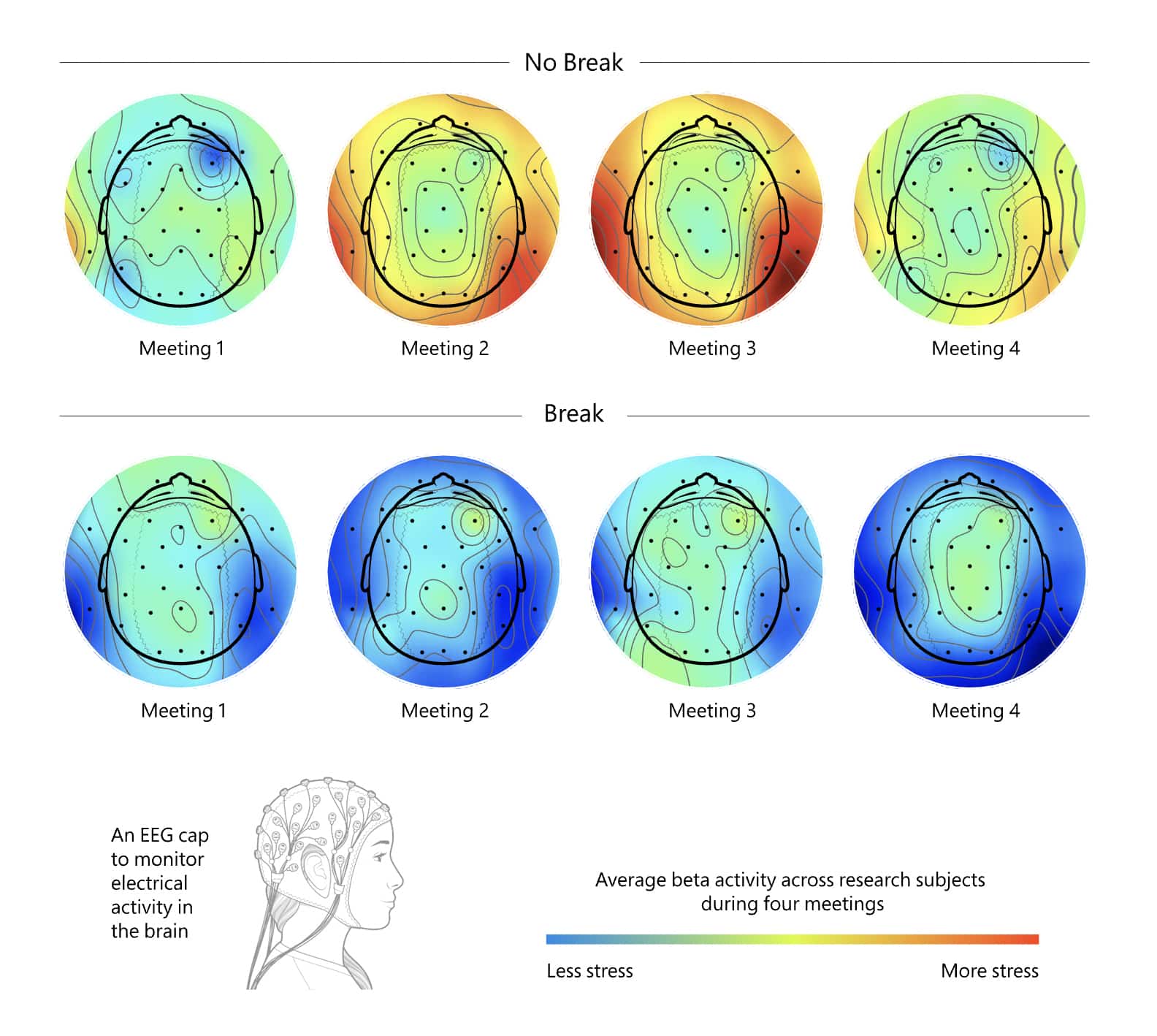
Take a Break! Why Work Breaks are Crucial, Especially if You’re Working from Home
It’s easy to pile on the hours when you’ve got a lot of work to do. And for those working remotely from home, work/life boundaries can become blurred, causing work tasks to interfere with healthy downtime. Back-to-back meetings can have remote workers sitting in front of their screens in high-focus mode for hours, without a chance to breathe in between. Research shows that this raises levels of stress, anxiety, and depression—and it lowers productivity too. That’s why work breaks are crucial and should be prioritized as part of every workday.
Research Shows: Work Breaks are Crucial for our Brains
When our brains are doing focused and engaged work, such as participating in meetings, they need breaks. That focus isn’t sustainable over long periods—stress and then fatigue will set in. One study asked participants to wear electroencephalogram (EEG) caps to track their brain waves during meetings. They were grouped into two categories: those with back-to-back half-hour meetings, and those with ten-minute breaks in between each of them. In the group taking breaks, participants spent that extra time listening to guided meditations with the Headspace app. (Meetings took place on a Monday; the following Monday the participant groups were switched, and then the results were averaged out.)

The EEG monitoring showed accumulated stress in those who didn’t take breaks. This was measured by beta wave activity, which is associated with concentration as well as anxiety. This activity can continue to increase over time, causing stress levels to rise, until it eventually gives way to fatigue. (Other similar research has shown that even within one meeting, brain activity associated with concentration and information processing declines after about 30 minutes. In the case of these back-to-back meetings, starting new calls and changing topics stopped that natural process from happening for a while—so stress continued to build up.)
In contrast, those who did brief meditations between meetings remained in a state of low stress through all of the meeting time. Their beta activity stayed at a healthy baseline without any significant increases. The breaks they took allowed their brains to reset and refresh for the next meetings, which made all the difference.

Increase Productivity and Lower Stress through Breaks
Stress build-up ends up reducing focus and productivity, so that workers not only feel worse but don’t perform as well in their jobs either. That’s why brief work breaks are crucial—here are a few tips to make sure you incorporate them into your day and make the most of them.
Schedule Relaxed Time
Block off some small segments of time just for breaks. Step away from the computer during that time, and mark your availability status as away if necessary. Any activities that you enjoy and aren’t associated with work can be helpful here: maybe read a couple pages in a book, work on a drawing sketch, or water plants in your garden. Even little micro-moments like this can make a big difference—and by the end of the day or week you may find you’ve accomplished something nice within a hobby of yours.

Get Moving
One of the downsides to office and online work is that we end up doing too much sitting in the same position. Use break time to take a quick stroll, or just do some stretches, push-ups or jumping jacks. These movements don’t take much time and can re-energize you if you’re starting to feel your focus waning.
Try (a) Pomodoro
A good rule of thumb is to plan for a five-minute break for every 25 minutes of work, or a ten-minute break for every 50 minutes—in other words, a 5:1 work-to-break ratio. This is sometimes called the Pomodoro technique, after the Italian Francesco Cirillo, who used a kitchen timer shaped like a tomato (pomodoro in Italian) to limit himself to 25-minute bursts of productive time followed by short restorative breaks. This is a handy thought to keep in mind for meetings: plan to wrap up half-hour meetings at 25 minutes, or hour-long meetings at 5o minutes, if possible. Then you and your fellow meeting participants will have time to regroup for your next meetings or tasks.

Of course, grabbing an actual tomato is also a great way to refresh, especially if it’s an heirloom from your garden. Sprinkle in other healthy snacks like nuts, fruit, or veggies with your favorite dip, to keep your mind and belly happy through the workday.
Make Your Meeting Time Count
Finally, you can also reduce meeting stress build-up by planning meetings smartly. Sometimes it’s worth asking yourself if a meeting is really the best way to approach a task—some things can be addressed just as well through chat, file sharing, or a quick and more casual call. When meetings are the best route, make good use of the time by having notes or an agenda on hand. And, as appropriate, keep it fun! Team meetings can be more relaxing and less stressful if you can have some laughs while you get things done.
